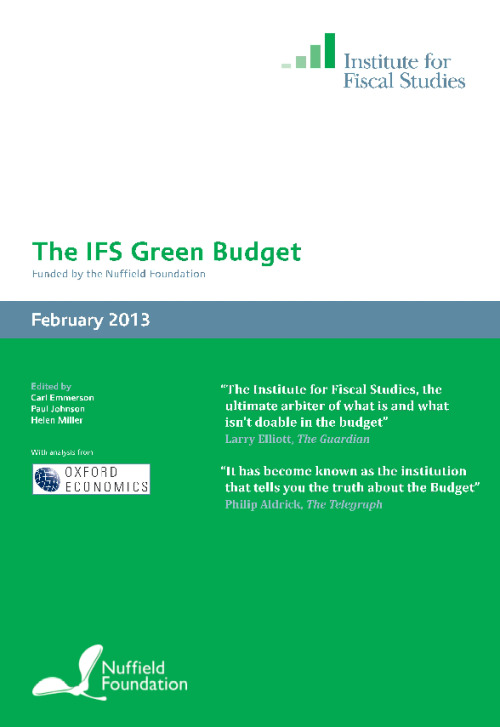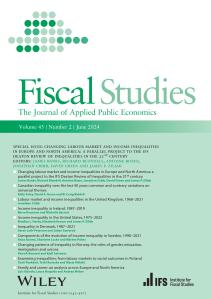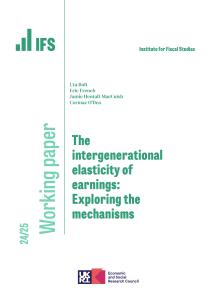The Green Budget 2013 was edited by Carl Emmerson, Paul Johnson and Helen Miller, and copy-edited by Judith Payne. It was funded by the Nuffield Foundation. The report was produced with analysis from Oxford Economics |
|
SUMMARY
Chapter 1: THE GLOBAL ECONOMY
1.1 Introduction
1.2 Global outlook
1.3 Risks to the global economy
1.4 Conclusions
Chapter 2: THE UK ECONOMIC OUTLOOK
2.1 Introduction
2.2 Will the recovery gain momentum in 2013?
2.3 More favourable factors to accelerate the pace of recovery next year
2.4 Medium-term recovery slower than usual
2.5 Comparison with other forecasts
2.6 Risks are now more balanced: alternative scenarios for the UK economy
2.7 Conclusions
Chapter 3: THE PRODUCTIVITY PUZZLES
3.1 Introduction
3.2 The trend in measured labour productivity
3.3 Composition of industries
3.4 The composition of the workforce
3.5 The labour market
3.6 Investment
3.7 Public sector productivity
3.8 Conclusions
Chapter 4: THE FISCAL TARGETS
[Download data for chapter 4 graphs]
4.1 Introduction
4.2 The Chancellor’s fiscal targets
4.3 Ensuring fiscal sustainability in Europe? The stability and Growth Pact
4.4 Principles of good fiscal management
4.5 How good are the Chancellor’s fiscal rules?
4.6 A better debt rule?
4.7 Conclusions
Chapter 5: PUBLIC FINANCES: OUTLOOK AND RISKS
[Download data for chapter 5 graphs]
5.1 Introduction
5.2 The disease
5.3 The cure
5.4 Risks to the public finances
5.5 Conclusions
Chapter 6: PUBLIC SPENDING AND PAY
6.1 Introduction
6.2 Departmental spending since 2010-11
6.3 Public sector pay and employment
6.4 Conclusions
Chapter 7: TAX AND WELFARE REFORMS PLANNED FOR 2013-14
7.1 Introduction
7.2 Tax and welfare reforms planned for 2013-14
7.3 Personal tax reforms
7.4 Welfare reforms
7.5 Distributional impact of tax and benefit reforms in 2013-14
7.5 Conclusions
Chapter 8: OPTIONS FOR CUTTING SPENDING ON SOCIAL SECURITY
8.1 Introduction
8.2 Current spending on social security
8.3 How we got here: benefit and tax credit changes since 1997
8.4 Options for future savings
8.5 Conclusions
Chapter 9: BROAD SHOULDERS AND TIGHT BELTS: OPTIONS FOR TAXING THE BETTER-OFF
9.1 Introduction
9.2 How much do the better-off have?
9.3 How much do the better-off pay in tax?
9.4 How have the better-off contributed to the fiscal consolidation to date?
9.5 Options: broad-based tax increases on income and spending
9.6 Options: increasing income tax and the NIC rates for higher earners
9.7 Options: capital gains tax
9.8 Options: taxation of private pensions
9.9 Options: taxes on wealth and housing
9.10 Conclusions
Chapter 10: CORPORATE TAX, REVENUES AND AVOIDANCE
10.1 Introduction
10.2 Corporate tax revenues
10.3 Taxation of multinationals and avoidance
10.4 Taxation of North Sea oil and gas
10.5 Conclusions
APPENDICES
[Download data for graphs in the appendices]
Appendix A: Forecasting the public finances
Appendix B: Headline tax and benefit rates and thresholds
Appendix C: Abbreviations
© The Institute for Fiscal Studies, February 2013











